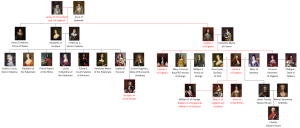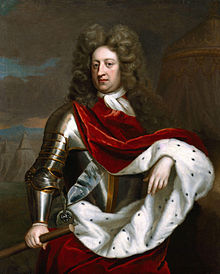A fascinating look, if a bit suspect, at one of the scandalous and remarkable Stuart (and particularly the first Caroline court) contemporaries, Lady Lucy Hay nee Percy, Countess of Carlisle, who was allegedly the mistress of James I & VI and Charles I’s favorite the Duke of Buckingham and a close friend of Charles I’s queen Henrietta Maria in the early years of Charles and Henrietta’s reign.
Myth #1: Was Prince George Really a Stupid, Simple-Minded Dullard?
There is today a common, popular story about Queen Anne’s prince consort that goes that he was an idiotic, simple fool who let himself be unnaturally dominated by his wife. But, as I set out to prove in this post which will be the first of many discussing myths surrounding the Stuart dynasty that I will debunk or deconstruct, this is a misconception and quite exaggerated that it is a disrespect to the Prince’s memory when people thoughtlessly portray him to be such, when in fact we should be careful and respectful seeing that he was a real complex, fascinating human being who lived and died in this world.
So what then is the truth about Prince George’s nature?
Love in the Time of the Stuarts: James I & VI of England and Scotland/Anne of Denmark
James I & VI of England and Scotland and Anne of Denmark are today remembered in history as the royal couple under whom the three kingdoms of England, Scotland, and Ireland were united in 1603, following the death of Elizabeth I of England and James’s ascension to the English throne as the great-great-grandson of Margaret Tudor, the eldest sister of Elizabeth I’s father Henry VIII. Traditionally, they have also been treated by historians as a foolish, incompetent king and frivolous, lightweight queen but in recent decades, their characters and reputations are being reexamined and they are now seen more as a serious, thoughtful monarch and an assertive, effective queen whose keen championing of the arts left a relatively large impact on the society that she lived in.
So who were James and Anne in their lifetimes, individually and as spouses?
[To be continued…]
Stuart Family Tree

A comprehensive albeit incomplete family tree for the Stuart monarchs who ruled England, Scotland, and Ireland from 1603 to 1714.
The House of Stewart (latterly gallicised to Stuart), is a European royal house. Founded by Robert II of Scotland, the Stewarts first became monarchs of the Kingdom of Scotland during the late 14th century, and subsequently held the position of the Kings of England, Ireland, and Great Britain. Their patrilineal ancestors (from Brittany) had held the office of High Steward of Scotland since the 12th century, after arriving by way of Norman England. The dynasty inherited further territory by the 17th century which covered the entire British Isles, including the Kingdom of England and Kingdom of Ireland, also maintaining a claim to the Kingdom of France.
In total, nine Stewart monarchs ruled just Scotland from 1371 until 1603. After this there was a Union of the Crowns under James VI & I who had become the senior genealogical claimant to The Crown holdings of the extinct House of Tudor. Thus there were six Stewart monarchs who ruled both England and Scotland as well as Ireland (although the later Stuart era was interrupted by an interregnum lasting from 1649 to 1660, as a result of the Wars of the Three Kingdoms). Additionally, at the foundation of the Kingdom of Great Britain after the Acts of Union, which officially united England and Scotland politically, the first monarch was Anne, Queen of Great Britain. After her death, the kingdoms passed to the House of Hanover, under the terms of the Act of Settlement 1701 and the Act of Security 1704, which deprived the Catholic legitimist line of the Stewarts of the right to mount the throne.
During the reign of the Stewarts, Scotland developed from a relatively poor and feudal country into a prosperous, modern and centralised state. They ruled during a time in European history of transition from the Middle Ages, through the Renaissance, to the midpoint of the Early modern period. Monarchs such as James IV were known for sponsoring exponents of the Northern Renaissance such as the poet Robert Henryson, and others. After the Stewarts gained control of all of Great Britain, the arts and sciences continued to develop; many of William Shakespeare’s best known plays were authored during the Jacobean era, while institutions such as the Royal Society and Royal Mail were established during the reign of Charles II.
Hello!
Hello there! 🙂 My name is Dawn and I’m a history geek whose specialties are mostly ancient, medieval, early modern, royal, and European history.
Recently, I’ve become very fascinated by the House of Stuart which ruled Scotland from 1371 to 1603, the Three Kingdoms of England, Scotland, and Ireland from 1603 to 1707, and Great Britain and Ireland from 1707 to 1714, though I also like and am interested in the other royal dynasties of England such as the Norman dynasty, the House of Plantagenet and its cadet branches the Houses of Lancaster and York, the House of Tudor, the House of Hanover, and the House of Saxe-Coburg and Gotha later renamed as the House of Windsor. And what better way to quench my interest than creating a blog simply dedicated to these fascinating, complex, and morally ambiguous rulers?
Be warned, however, that I will be mostly posting about the Stuart monarchs from 1603-1714 since they’re the ones who first caught my interest and the ones I would most love to learn more about, so sorry if you’re more interested in the earlier Stuarts who merely ruled Scotland!

